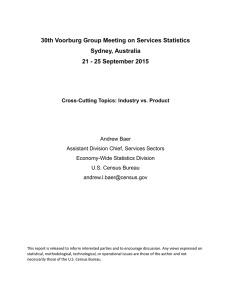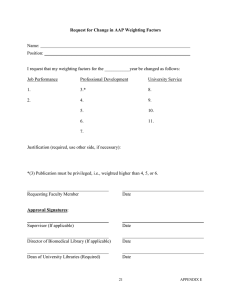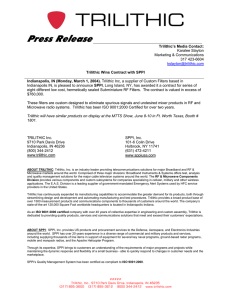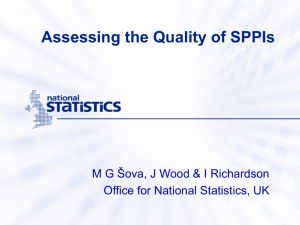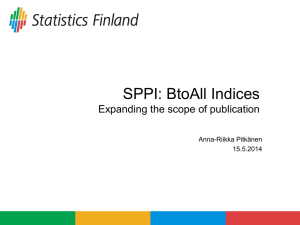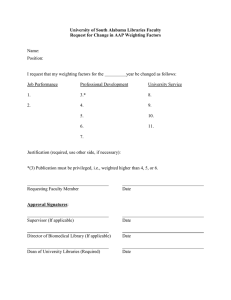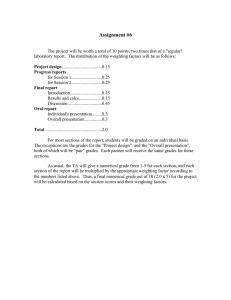29th Voorburg Group Meeting on Services Statistics
advertisement
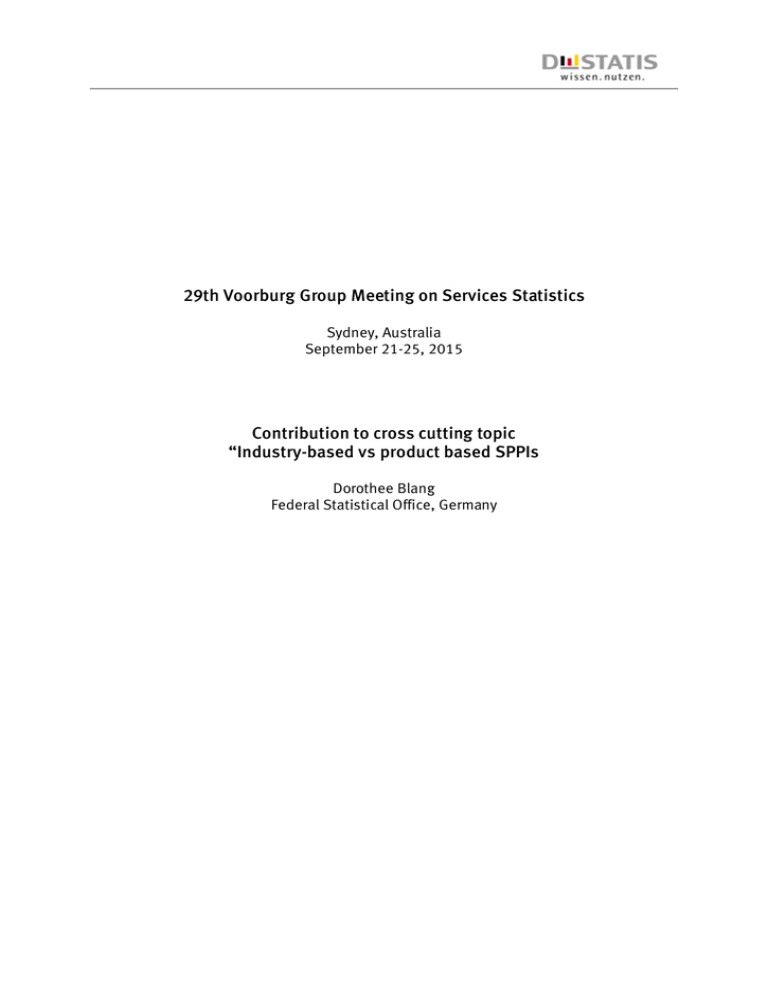
29th Voorburg Group Meeting on Services Statistics Sydney, Australia September 21-25, 2015 Contribution to cross cutting topic “Industry-based vs product based SPPIs Dorothee Blang Federal Statistical Office, Germany Contribution to cross cutting issue „Industry-based vs product-based SPPIs” Index of contents 1. Definition ............................................................................................................................ 3 2. Purposes of SPPIs:.............................................................................................................. 4 2.1. Observation of short term economic development .................................................... 4 2.2. Indicators for achieving the objective of price stability ............................................. 4 2.3. Deflators inter alia to calculate real GDP development ............................................. 4 2.4. Adaption of recurrent payments in business contracts (stable-value clauses)......... 4 3. Population........................................................................................................................... 5 4. Weighting schemes ............................................................................................................ 5 5. Communication:.................................................................................................................. 7 6. What follows from this? ...................................................................................................... 8 Page 2 of 8 Contribution to cross cutting issue „Industry-based vs product-based SPPIs” Industry-based SPPI versus product-based SPPI – some issues 1. Definition In a first step, we should agree on the definition of industry-based and product-based SPPIs. The Eurostat-OECD methodological guide for developing producer price indices for services defines the two index types as follows: An industry based index is created from a sample of business enterprises classified under that industry. All of the output of these sampled units is represented, even secondary activity output that is classified under other industries in the international classification systems, and aggregated to form these (4-digit) industry level indices. Product based indices are created from samples of products. All service product output (obtained from lists of producers of each product) is eligible for selection, regardless of the classification of the business enterprises that produce it. Price movements for products are generally aggregated to form product Group or product Class level indices … Do we mean the same by these two concepts? The following scheme of an output table by product and by industry illustrates the definitions. In this universal example it is assumed that product 3 is the main product of industry C. Thus, for the industry-based index it is assumed that it incorporates products that are secondary activities for this industry. And for the product-based index it is assumed that it incorporates observations of units outside of industry C, that are offering products of product group 3 as secondary activities. It‘s obvious, that the contents of the 2 different index concepts may widely differ from each other and the intersection set might be rather small. Graphic 1: scope of industry-based and product-based SPPIs Industry A Industry B Industry C Industry … Sum of Industries Productgroup 1 Productgroup 2 Productgroup 3 ·· · Sum of Products In the VG-meetings we work out the methodology for surveys on turnover and prices for industries – one by one. One might understand implicitly that this means we are all talking about industry-based SPPIs. As we learnt from former mini-presentations this does not always apply. But perhaps for our future work, we should state more precisely, what we are talking about. Page 3 of 8 Contribution to cross cutting issue „Industry-based vs product-based SPPIs” 2. Purposes of SPPIs: It can be assumed that for different purposes of SPPIs different index concepts are appropriate. Thus, we should ask for which purposes SPPIs are used. From the description of the purpose for which the producer price indices are used one may be able to conclude which kind of index concept fits best. 2.1. Observation of short term economic development In the EU legislation the SPPIs are defined as short term statistics indicators. Although they represent only a component in the calculation of indices of service production, the price trend itself is also an indication for the ratio of supply and demand. E.g. the development of freight rates in sea and coastal shipping during the economic crisis suggested huge overcapacity. As components in the calculation of volume indices for the observation of short term developments an industry-based SPPI seems to be the appropriate choice because the turnover development is available for industries as well. In most countries for the service sector turnover by product is only available on a yearly basis or every 5 years. 2.2. Indicators for achieving the objective of price stability SPPIs show the price trend on the manufacturer’s site. Price development on the manufacturer’s site represents – if we focus on the b2b part of it – the price trend on an early stage in the economic process (compared to the CPI). The observation of price trends on this stage in the economic process may indicate future price development on the consumer site. Thus, the SPPIs represent a component in the observation of price stability. If we want to assess the influence of prices of inputs on the price development of final consumption we need to observe the prices of input products. Hence for this purpose productbased SPPIs – irrespective of the industry of the provider – seem to be the appropriate choice of index concept. 2.3. Deflators inter alia to calculate real GDP development In most countries the development of real value added is calculated by so-called double deflation. This means that in a first step production values and the values of their inputs are deflated separately. The real value added is calculated in a second step as the difference between deflated production values and deflated input values. For both deflations – deflation of production and deflation of inputs – we need product-based SPPIs. 2.4. Adaption of recurrent payments in business contracts (stable-value clauses) An application of SPPIs outside of the statistical system is the use in stable value clauses. The purpose of stable value clauses in contracts is mainly the hedging against fluctuations in input costs. Enterprises connect the prices of their services to the price development of certain essential input products for which the price may be erratic and not predictable, e.g. freight rates. Hence, the stable value clause references the price development of input products and thus, product-based SPPIs seem to be most appropriate for this purpose. Page 4 of 8 Contribution to cross cutting issue „Industry-based vs product-based SPPIs” 3. Population We have seen that for most purposes of SPPIs the use of product-based SPPIs seems to be the appropriate choice. According to the definition of product-based and industry-based SPPIs we may assume that the populations of enterprises which might submit price declarations for the one or the other SPPI differ. Then, it is a very central issue, what could be the data source for the sampling for a product-based index? Business registers provide appropriate data for the sampling for an industry-based SPPI although it remains the problem that there is often no information available on the specific products that are offered by the entities classified in a certain industry. Graphic 2: sources for sampling Sampling from Surveys on Turnover by Product? Sampling from Business Register? The identification of the population of entities that offer a specific product – independently of the industry they belong to – is much more challenging. Some countries conduct business censuses every five years and ask for turnover by product in these surveys. In these cases at least in multiannual intervals the data required for product-based samples is available. In Germany this applies for industrial production. But similar surveys don’t exist for the service sector. The most important data source for the activities of enterprises is the statistical business register with the classification of enterprises according to their principal activity. Even if the business register provides an additional NACE-code of a secondary activity there is no information on the share of turnover of this additional business. Nevertheless the sampling of enterprises must be free of arbitrariness. Thus, it can cause problems if you ask a company for statistical reporting only on the basis of knowledge of the specific case without the knowledge of the population and without selection plan. 4. Weighting schemes The question of the sources of data arises again in connection with the calculation of weighting schemes. In Germany, a survey on turnover by product is only available for very few industries of the service sector. This supplementary survey on structural business statistics is based on the NACE classification of the entity. Here again, no statistical figures on product turnover generated by entities which are classified in other industries are available. Page 5 of 8 Contribution to cross cutting issue „Industry-based vs product-based SPPIs” Assumed that all data we need for calculation of weighting schemes is available, three different SPPIs might be calculated: - A product-based index, for which the weighting scheme averages the revenue shares of the individual products of a product group of all industries that offer these products: Graphic 3: Weighting of a product-based SPPI for product-group 3 Industry A Industry B Industry C Industry … Sum of Industries Productgroup 1 Productgroup 2 Productgroup 3 Productgroup 4 · · · - An industry-based SPPI for which the weighting scheme is calculated by the share of turnover of primary and secondary products offered by the respective industry: Graphic 4: Weighting of an industry-based SPPI for industry C Industry A Industry B Industry C Industry … Sum of Industries Productgroup 1 Productgroup 2 Productgroup 3 Productgroup 4 · · · Page 6 of 8 Contribution to cross cutting issue „Industry-based vs product-based SPPIs” - A sub-index of the industry-based SPPI representing only primary products of the industry weighted by their share of turnover within the respective industry Graphic 5: Weighting of industry-based SPPI for product-group 3 (sub-index) Industry A Industry B Industry C Industry … Sum of Industries Productgroup 1 Productgroup 2 Productgroup 3 Productgroup 4 · · · It is assumed that the weighting pattern for the main products of Industry C and the weighting pattern for this product group independently from the industry of the providers differ from each other. This results in three different SPPIs with – in worst case – very similar-sounding names. E.g. for cargo handling this might lead to - an industry-based SPPI “cargo handling” - potentially a sub-index of the industry-based SPPI for the main product group “cargo handling services” - a product-based SPPI for the product group „cargo handling services“ independently of the classification of the entities offering these services Which of these do I want to publish? 5. Communication: And this leads to the consequent question: How can we explain the different concepts and contents to the users? As we have seen, often the names of the sectors and the names of the services are very, very similar. This makes it difficult to differentiate between publications of product-based and industry-based indices. What kind of metadata is necessary in order to explain the concept to users beyond the statistical system? Is it possible to publish and to explain both kinds of SPPIs without confusing the user? Page 7 of 8 Contribution to cross cutting issue „Industry-based vs product-based SPPIs” 6. What follows from this? - Is the index-type a specification that should be mentioned in future mini-presentations? - If we do so, should the presenters give some additional facts about - specific sources for weighting schemes for the respective index type? - data sources for the population for sampling? - meta data provided with publication of results? - What are the challenges of the respective index-type and what are its advantages for the respective industry? Page 8 of 8
